You might be here because you spotted a beautiful black bird with a blue head, and you’re desperately trying to find out its species. Or maybe you’re just a bird enthusiast who’s eager to learn about some of the world’s most unique birds!
Well, either way, you’re in the right place! You won’t believe the plumage fanciness these birds possess! Keep reading to discover more about them!
10 Types of Black Birds With Blue Heads
Brace yourselves because you’re about to read about some truly amazing birds! You won’t even believe how stunningly beautiful their plumage is!
However, before discussing these species, we must mention that not all are completely black with blue heads.
Most feature bluish feathers on other parts of their bodies, white underparts, or black-brownish plumage. Some are completely black but exhibit blue iridescent.
Finding birds with purely black bodies and blue heads is almost impossible. Still, we selected the species that are the closest to this description, so you definitely don’t want to miss them!
1. Common Grackle
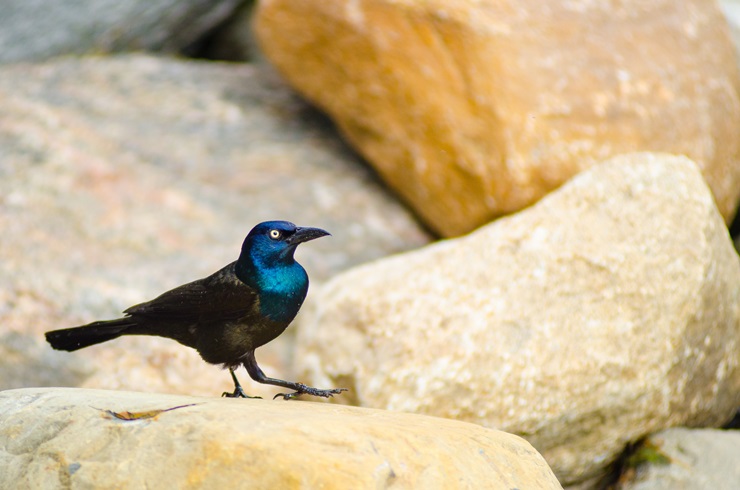
- Scientific name: Quiscalus quiscula
- Size: 28-34 cm (11-13 in)
- Weight: 74-142 g (2.6-5 oz)
- Wingspan: 36-46 cm (14–18 in)
Common grackles are among the world’s most popular birds thanks to their distinctive plumage! After all, they have black bodies and blue heads! But there’s much more to it than this!
Their feathers appear to have a combination between black and purple or green on the rest of the body and blue on the head. This iridescence is more observable in adult males than in females.
This species is part of the Icteridae family of New World passerine birds. They are native to North America.
Some populations are year-round residents, while others fly for the south when the temperatures drop. However, they restrict their range east of the Rocky Mountains, where they’re found in open and semi-open habitats. During the breeding season, common grackles build cup nests in pine trees or shrubs.
Common grackles are omnivorous. They do not have a specific preferred type of food and will eat various insects, crayfish, frogs, seeds, berries, and sometimes even small birds. These birds usually feed on the ground.
2. Purple Martin

- Scientific name: Progne subis
- Size: 19-20 cm (7.5-7.9 in)
- Weight: 45-60 g (1.6-2.1 oz)
- Wingspan: 39-41 cm (15.3-16.1 in)
We’ve all heard of the famous purple martins! These passerine birds are North America’s largest swallow species! Needless to say, they’re renowned for their bluish plumage shade (despite them being called purple!).
Purple martins are found across the Americas. During the breeding season, these birds stay in the open areas of eastern North America. When the temperatures drop, they fly to Bolivia, Brazil, and Peru. Males return to the breeding grounds before the females to establish territory.
Male and female purple martins have a slightly different appearance, but both have some blue markings. The males are entirely black but have a glossy blue appearance, especially on their heads.
Females, on the other hand, have light underparts, dark upperparts, and blue spots on their heads and wings. Juvenile purple martins do not exhibit the same distinctive bluish coloration, as it takes them approximately two years to fully mature in terms of plumage.
These black birds are insectivores and usually catch insects while flying. Studies show that many purple martins prefer feeding on invasive fire ants.
3. Shiny Cowbird
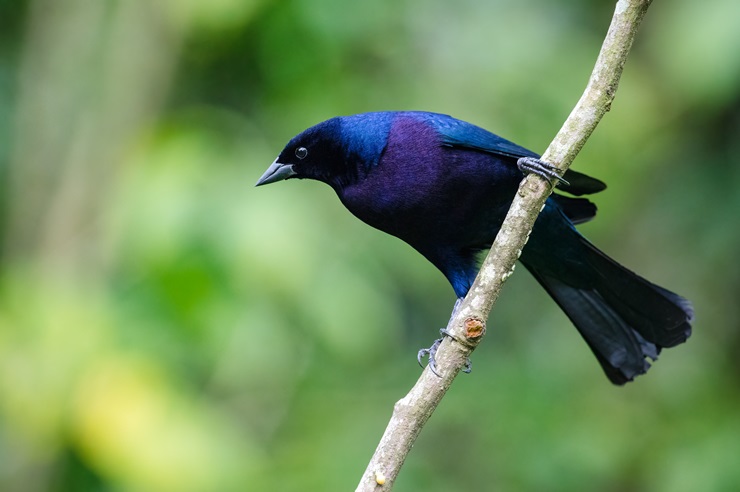
- Scientific name: Molothrus bonariensis
- Size: 18-22 cm (7-8.7 in)
- Weight: 31-65 g (1-2.3 oz)
- Wingspan: 30 cm (11.8 in)
Like the common grackle, the shiny cowbird is part of the Icteridae family of passerine birds. Unlike its relatives, however, the shiny cowbird is a year-round resident of South America.
The species is known to be divided into seven subspecies, grouped according to their geographic distribution. Within their range, common grackles are found in open forests and cultivated lands.
The subspecies can also be distinguished based on physical traits. For example, Molothrus bonariensis minimus is much smaller than Molothrus bonariensis cabanisii.
However, it is known that all subspecies feature black plumage with more or less purple-blue iridescence, which is more noticeable in males. The purple and blue mark not only their heads but also their wings.
Females, on the other hand, do not exhibit this rich iridescence, as their plumage is usually gray-brown and very pale.
The shiny cowbird is primarily insectivorous, although it may occasionally delight in a seed or grain meal.
4. Purple Sunbird
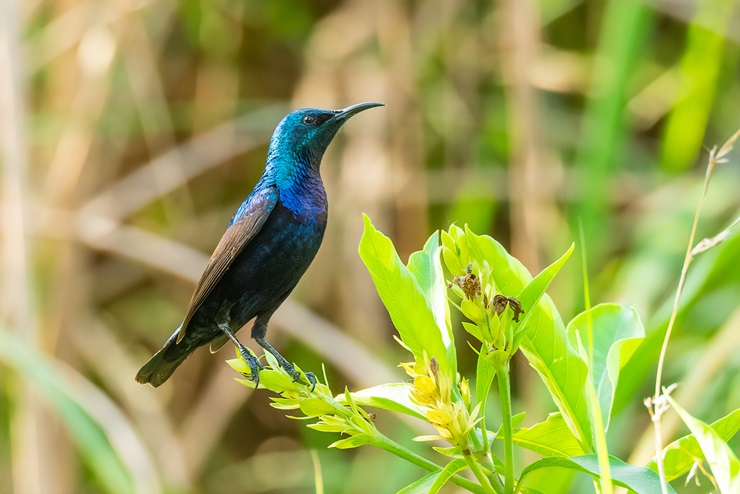
- Scientific name: Cinnyris asiaticus
- Size: 10-25.5 cm (4-10 in)
- Weight: 5.7-45.4 g (0.2-1.6 oz)
Yet another stunningly beautiful bird on our list – the purple sunbird!
Purple sunbirds are pretty small, but their plumage makes them unmistakable! Male purple sunbirds have black plumage interspersed with blue-purplish and dark brown feathers. During the breeding season, their heads are strikingly blue, and the color extends to parts of their necks and backs.
Females do not have the same coloration. Outside the breeding season, they’re olive brown, have a yellow underside, and dark purple-bluish wings. Young purple sunbirds have the same coloration.
This species has been previously known to live only in South and Southeast Asia. Today, however, it is also found on the Arabian peninsula. Purple sunbirds aren’t typically migrants, preferring to remain all year round within their range, inhabiting forests and gardens.
During the breeding season (January-June), they build pouches from cobwebs, bark, and lichens.
Unlike other birds on our list, purple sunbirds aren’t insectivorous, as they feed mostly on nectar and only occasionally take insects and fruits.
5. Brewer’s Blackbird
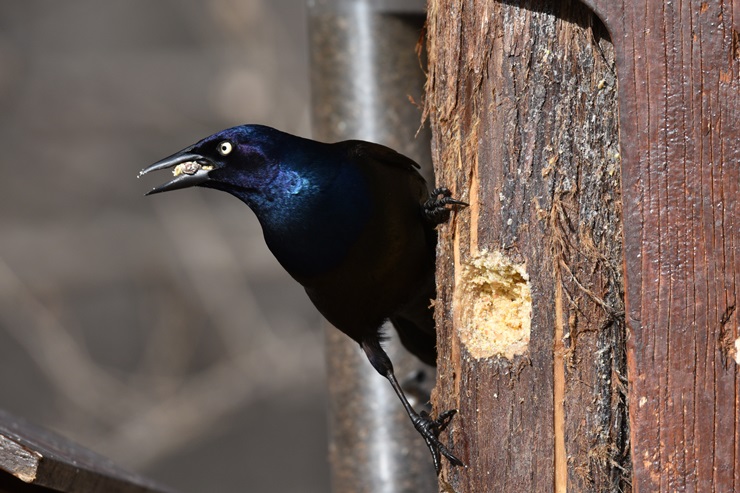
- Scientific name: Euphagus cyanocephalus
- Size: 20-26 cm (8-10.3 in)
- Weight: 63 g (2.2 oz)
- Wingspan: 39 cm (15.5 in)
Like other species on our list, the Brewer’s blackbird is part of the Icteridae family.
As in other birds we’ve mentioned, the bluish plumage is noticeable in male Brewer’s blackbirds. They have black body plumage and iridescent purple-bluish heads and necks. On the rest of the body, the black plumage is interspersed with blue-greenish feathers.
Females, on the other hand, are brownish-gray and do not feature the same degree of iridescence as males.
This species is endemic to North America and prefers open or semi-open habitats, being more common near water sources.
In the western part of the continent, Brewer’s blackbirds are year-round residents. The northern populations are migratory and prefer spending their winters in the Southern United States and Mexico. These birds are social creatures and their nests are built in colonies of around 30 pairs.
As for their diet, Brewer’s blackbirds eat seeds, insects, and berries. They prefer foraging close to water sources, in shallow water, in fields, or in flight.
6. Rook Bird
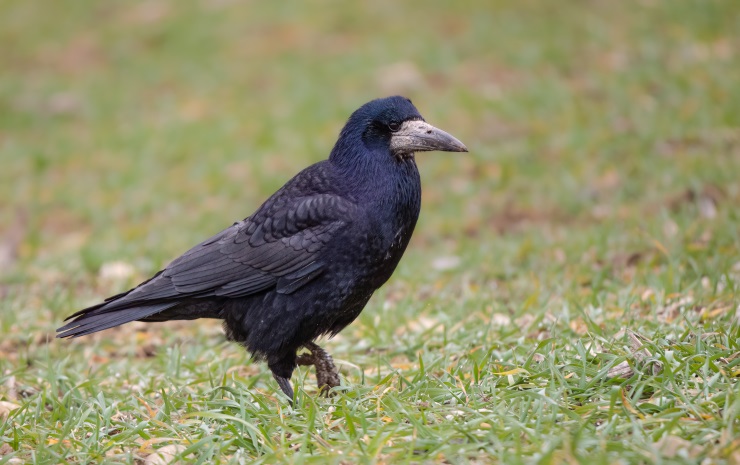
- Scientific name: Corvus frugilegus
- Size: 44-46 cm (17-18 in)
- Weight: 280-340 g (9.9-12.0 oz)
- Wingspan: 81-99 cm (32-39 in)
Who would’ve known that a Corvus species has such stunning plumage?! However, the truth is, not all are purely black, and the rook isn’t the only one with amazing feather shades!
If you observe a rook bird in sunlight, you’ll notice it looks unusually blue! In the shadow, however, the bird appears black with only a few bluish shades on its head and feathers. The bluish color is especially noticeable on its head and neck because those feathers are unusually dense and silky.
These birds are common in Eurasia, preferring to reside in open agricultural areas with tall trees they rely on during the breeding season. Some populations are residents, while others prefer to migrate long distances between their breeding and wintering grounds.
These rooks feed primarily on vegetable foods like potatoes, roots, fruits, and acorn, but may occasionally enjoy earthworms, beetles, millipedes, and even carrion.
7. Asian Fairy-Bluebird
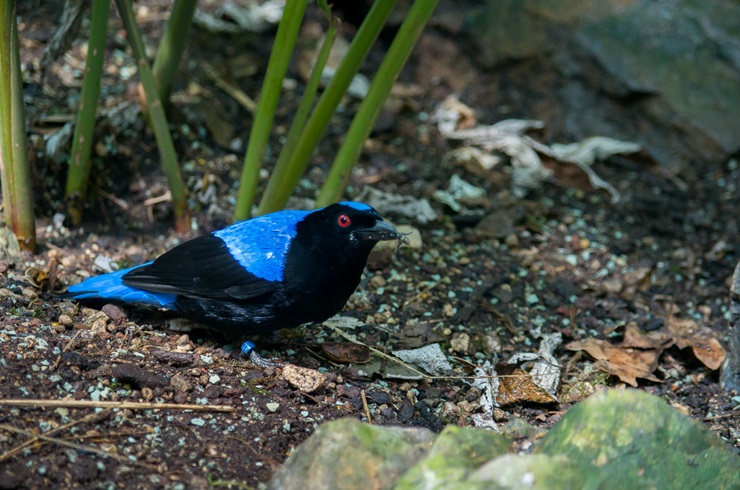
- Scientific name: Irena puella
- Size: 24-27 cm (9.4-10.6 in)
- Weight: 50-100 g (1.8-3.6 oz)
The Asian fairy-bluebird undoubtedly lives up to its common name, as it has remarkably beautiful plumage!
Males have distinctive ultramarine-blue patches on the upper parts (including the upper part of the head) and under tail coverts. The rest of the feathers, including those on the sides of the head, are deep black.
Females are slightly different – they are predominantly brownish-black with dark blue feathers. The sides of the head are blue, just as the upper parts and the lower parts.
The species is endemic to southern Asia, the Greater Sundas, and Indochina. They’re usually found in tropical forests. During the breeding season (February-April), these birds build shallow cup nests in small trees, where they lay 2-3 eggs.
Contrary to what we’d expect, Asian fairy-bluebirds feed primarily on fruits.
8. Blue-necked Tanager
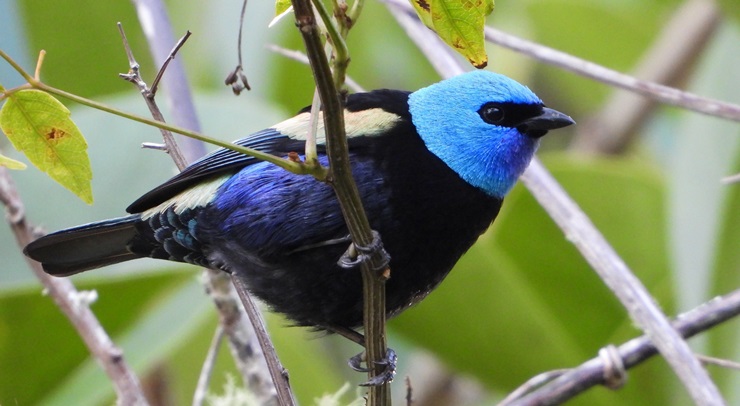
- Scientific name: Stilpnia cyanicollis
- Size: 12 cm (4.7 in)
- Weight: 17 g (0.6 oz)
The blue-necked tanager is part of the Thraupidae family of birds. The species is endemic to South America, where it inhabits tropical and subtropical moist lowland forests. These gorgeous birds are also found in moist montane forests.
During the breeding season, females build nests in well-hidden places. Upon hatching, both parents take care of their babies and may even ask other birds for help to provide the little ones with food.
But enough about their behavior! We’re here for these birds’ stunning appearance! As their common name suggests, their heads and necks are of a vibrant greenish color.
This patch is distinctly separated from the rest of the plumage, which is black interspersed with blue and green feathers of various shades. If you’re a bird enthusiast, you should definitely add seeing this bird in real life to your bucket list!
As for these beautiful creatures’ diet – it typically consists of berries, fruits, and insects, which are caught either in flight or picked from leaves.
9. Blue-black Kingfisher
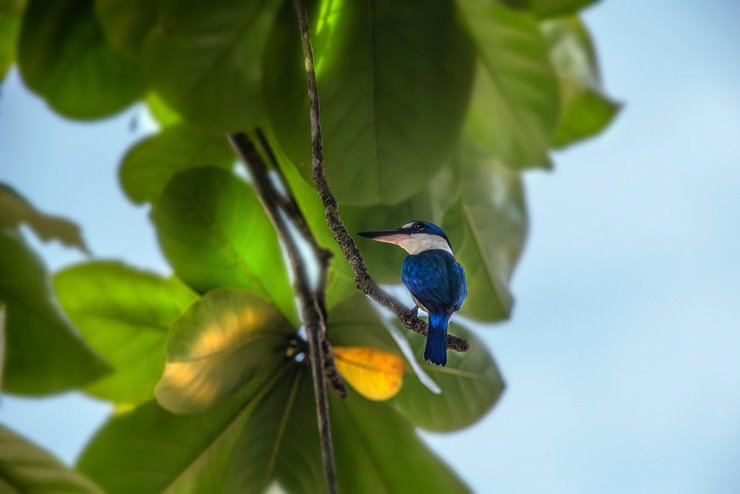
- Scientific name: Todiramphus nigrocyaneus
- Size: 23 cm (9.1 inches)
- Weight: 51-57 grams (1.8-2 ounces)
Yet another truly remarkable bird with fascinating plumage – the blue-black kingfisher!
These small creatures have a very interesting feather arrangement. They are indeed brightly colored, but only on some parts of their bodies, as the others are purely black. The face, for example, is black, but the top of the head is bright blue, and the throat is white.
There are some patches of dark and light blue on the wings and the tails, while the underparts are usually white in females and rufous in males.
This brightly-colored bird is found only in New Guinea and on the islands of Yapen, Batanta, and Salawati, where they’ve settled in forested streams and mangroves, being year-round residents.
10. Black Grouse
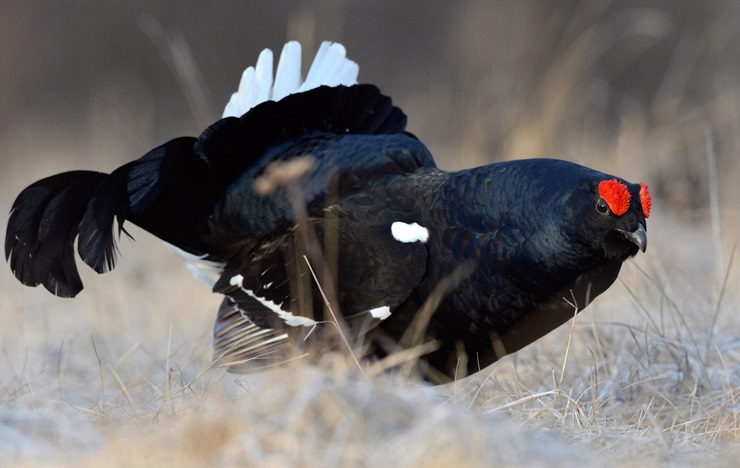
- Scientific name: Lyrurus tetrix
- Size: 45-60 cm (18-24 in)
- Weight: 750-1,250 g (1.65–2.76 lb)
- Wingspan: 65-80 cm (25.5-31.4 in)
The black grouse is probably the largest species on our list. It’s part of the Phasianidae family alongside pheasants, junglefowl, peafowl, and turkeys.
Male black grouses are predominantly black and feature blue feathers on the head, neck, and back, as well as a white wing line and a distinctive red bare skin patch above the eyes.
Females aren’t as distinguishable in terms of plumage, as their feathers are usually cryptically colored so they can blend easily with their surroundings.
These large game birds are found in moorland and steppe habitats during the breeding season and dense forests during the winter. They are spread throughout Eurasia.
Before mating, male black grouses are known to engage in a very distinctive courtship display which implies fanning their tails and inflating their necks, at the same time producing their courtship song, thus attracting females.
Black grouses are known to be very fond of conifer needles.
